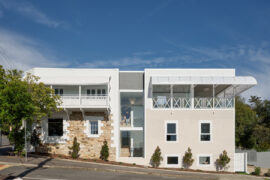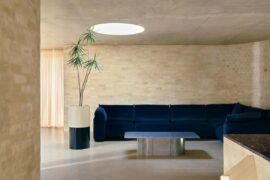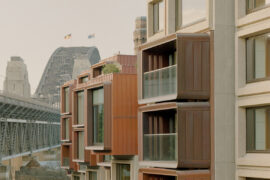Researchers have created a series of guides to support wellbeing for architects, after a survey found architecture workers had a lower-than-average quality of life compared with Australia’s general working population.

May 14th, 2024
Led by RMIT Professor Naomi Stead in collaboration with Monash University researchers and eleven architecture industry partners, including award-winning advocacy group Parlour, the five guides were designed in response to a three-year RMIT-led research project. The Wellbeing of Architects: Culture, Identity and Practice study found two thirds of architects experienced at least some level of psychological distress.
The ARC-funded research also funded more than one quarter of respondents had experienced moderate to severe psychological distress, while 42% reported their work had a generally negative impact on their wellbeing.
Many of the research participants indicated that there was a discrepancy between effort and reward in architectural work – given relatively low pay, long hours, pressured deadlines and intense risk and complexity.
“Sometimes, in architectural work, people feel like the juice isn’t worth the squeeze,” Stead said.
Poor wellbeing was most acute in respondents under 36 years old, who were nearly twice as likely to report moderate to severe psychological distress compared to respondents in older age groups.
“Rather than flourishing, parts of this community can best be described as languishing,” said Stead, who is the Director of the Design and Creative Practice Enabling Capability Platform at RMIT.
“One of the most notable and concerning findings was that in 2023, the wellbeing of respondents was significantly lower than the Australian population in general and was substantially lower again than our earlier survey in 2021.”
“All items from the personal wellbeing index were rated lower in 2023 than in 2021. This was particularly notable in relation to future security, achievement in life, health, and standard of living.”
The launch of the Guides to Wellbeing in Architectural Practice
Stead will be launching the series of five guides at a two-day symposium, The Wellbeing of Architects: Education and Practice, held at Collingwood Yards on May 8-9.
As a free online resource, the downloadable “Guides to Wellbeing in Architectural Practice” outline ways to improve wellbeing within architectural offices, with practical suggestions and advice for practices, professional bodies, and individuals – including advice for people on how to improve their own wellbeing within their workplace.
Stead said the guides identified and expanded on five major themes for improving wellbeing amongst architects.
“A key factor we found was that while architects are highly committed and believe that their work can make a positive difference in the world, society at large doesn’t necessarily see or understand that potential contribution – to the public domain, sustainability, and improving quality of life for all – amongst other things,” she said.
“This means unreasonable pressure on the time and money available to complete work – avoiding that would mean practices are in a better position to avoid disruptive redundancies, improve job security and satisfaction, and pay their people well.”
Trust, transparency and psychosocial and psychological safety were also found to be vital to a healthy and productive workplace.
Stead said everyone had a part to play in making positive changes to wellbeing across the architecture profession – as part of the larger construction industry.
“It doesn’t matter if you’re a director, project leader or just starting out in architecture, prioritising the wellbeing of all in the practice are key steps to making the industry a better place to work,” she said.
The symposium will present the study’s findings, as well as propose and discuss actionable recommendations to address the mental health and wellbeing issues prevalent in the architecture community.
The Wellbeing of Architects guides were published by and produced in association with Parlour, with key authors Susie Ashworth, Alison McFadyen, and Justine Clark. They are based on the model of the award-winning Parlour Guides to Equity in Practice which have been widely taken up in the architectural profession worldwide and adapted to other professions. Industry partners for the ARC Linkage project include the NSW Architects Registration Board, The Australian Institute of Architects, The Association of Consulting Architects, the Association of Australasian Schools of Architecture, BVN, DesignInc, Elenberg Fraser, The Fulcrum Agency, Hassell, and SJB.
Next up: Scott Adams comments on harnessing the power of design to transform cities
INDESIGN is on instagram
Follow @indesignlive
A searchable and comprehensive guide for specifying leading products and their suppliers
Keep up to date with the latest and greatest from our industry BFF's!

A curated exhibition in Frederiksstaden captures the spirit of Australian design
The new range features slabs with warm, earthy palettes that lend a sense of organic luxury to every space.

How can design empower the individual in a workplace transforming from a place to an activity? Here, Design Director Joel Sampson reveals how prioritising human needs – including agency, privacy, pause and connection – and leveraging responsive spatial solutions like the Herman Miller Bay Work Pod is key to crafting engaging and radically inclusive hybrid environments.

Jesse Lockhart-Krause, Director of Lockhart-Krause Architects, tells us about a storied building in Queensland that has now become a functional workplace for a therapy centre.

As French-Lebanese Architect Lina Ghotmeh prepares for lectures in Melbourne and Sydney, we hear about the philosophy shaping her internationally celebrated practice.
The internet never sleeps! Here's the stuff you might have missed

From the hottest new hotel to launches at industry’s most loved event: this local design house is making its mark

The INDE.Awards 2025 has crowned Sirius Redevelopment by BVN as the winner of The Multi-Residential Building, sponsored by CULT. This ambitious project redefines urban living in Sydney’s historic Rocks precinct while preserving heritage, reducing embodied carbon, and elevating residential design.